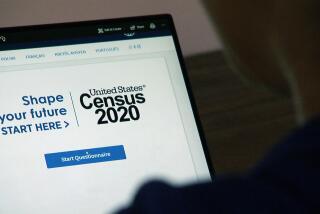Let Census Test End Debate
- Share via
The raucous political war over how the census should be conducted two years from now has claimed its most prominent casualty. Martha Farnsworth Riche, a respected demographer, has resigned as head of the Census Bureau, worn down by endless skirmishes with critics in Congress. Her departure has brought bipartisan expressions of regret. Far better if it leads to a resolution of a nasty and transparently partisan conflict.
The origins of the current fight lie in the 1990 census. It was the costliest in our history and quite possibly the most inaccurate, with subsequent studies indicating that as many as 10 million people were left uncounted while up to 6 million more were counted twice or listed as residents of the wrong place. These errors were not inconsequential. House seats are reapportioned on the basis of the decennial census. Federal money for a variety of programs is allocated on the same basis. The undercounting of California residents cost the state an estimated $500 million in federal funds and robbed it of one House seat.
Undercounting most commonly occurs when households fail to mail back census forms. Transients, including the homeless, are also often missed. The Census Bureau’s proposed remedy for the 2000 census is statistical sampling. A portion of non-responding households would be visited and the information gathered would allow estimates to be made for the larger number of households. Sampling is a recognized statistical tool, endorsed by the National Academy of Sciences.
But House Republicans, fearing a more accurate count could benefit urban Democratic office seekers, deride sampling as unconstitutional. They did, however, agree to a test of the technique in April. Sacramento will be one of the sites. If the test supports the validity of sampling, that should be the end of it. The goal is to achieve the most accurate census, not to try to stack the deck on reapportionment.
More to Read
Get the L.A. Times Politics newsletter
Deeply reported insights into legislation, politics and policy from Sacramento, Washington and beyond. In your inbox twice per week.
You may occasionally receive promotional content from the Los Angeles Times.









